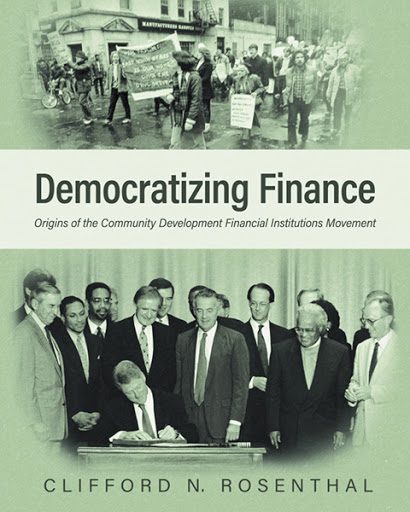
Trained as a historian, Rosenthal provides a thorough and nuanced history of the CDFI field and traces the antecedents of the community development finance back to the three F’s: Franklin, Freedmen’s, Filene.
Benjamin Franklin’s small-business loan funds helped finance small business in the 1700s and 1800s; the Freedman’s Bank provided financing to emancipated African Americans after the Civil War; and Edward Filene, the owner of Filene’s, a Boston-based clothing store, whose funding made possible the creation of the credit union movement of the early 20th century and founding of the Credit Union National Extension Bureau. Community development finance is steeped in U.S. history and it was not until the political and economic ecosystem in the 1990s became more receptive to the conditions and opportunities that laid the groundwork for the growth of the CDFI field. The self-help tradition goes way back in American history.
Rosenthal raises an important history lesson from the Office of Economic Opportunity Community Credit Union initiative in the 1960s. The credit unions were inadequately capitalized and most of them disappeared by the early 1970s. The lesson is that credit unions and what became other CDFIs need to be adequately capitalized and that federal policy and initiatives should invest in the capitalization of the CDFI’s equity to make them larger and more sustainable. This is in fact what happened with the creation of the CDFI Fund in 1994 and it’s a good example of how we can adapt policy initiatives from previous history lessons.
Another important theme in the book is the role of faith-based institutions in launching and helping to grow CDFIs. Religious and other social investors were searching for mission-based funds to invest in, and the results of their efforts—notably the creation of African-American community development credit unions and loan funds created by Catholic religious orders serving as seed investors—helped create the infrastructure that positioned CDFI movement for growth in the 1990s.
The book also sheds insight on some of the key institutions and leaders who helped build the CDFI field, including South Shore Bank, Self-Help Credit Union, Institute for Community Economics, and others. Rosenthal reminds us that South Shore Bank, which collapsed in the aftermath of the Great Recession of 2008 and 2009, was a pivotal institution in the growth of community finance. South Shore Bank was the first community development bank focused on low-income communities and it was able to raise significant capital to invest in businesses and residential real estate in low-income communities. The bank drew the attention of the Clintons through helping to establish Southern Bank Development Corporation in Arkansas, and its success galvanized incoming President Bill Clinton to make community development banks a centerpiece of his economic policy.
The major story in the book was how the CDFI Fund came into operation. The account includes the Rose Garden celebration on July 15, 1993, when President Clinton announced the introduction of a community development banking bill in front of several hundred banking and community leaders.
It took plenty of effort to get the CDFI Fund across the finishing line and enacted, but the Clinton administration, Congress, and the CDFI Coalition were able to work together to create the new program, which was signed into law on Sept. 23, 1994. A bank lobbyist commented, “I’ve never seen so much horsepower behind a banking bill.”
The story then shifts to operationalizing the CDFI Fund within the U.S. Department of the Treasury. Even with strong advocates and support from the Clinton administration, including Secretary of Treasury Robert Rubin, it was not easy to launch the fund. Congress, notably the Republican leadership in the House, threw several funding obstacles in the way of the CDFI Fund. The book offers an excellent case study of the challenges, commitments, and leadership needed to create a new federal program from scratch, especially one as complicated as the CDFI Fund. The book provides a detailed analysis from the time interim staff was hired in the fall of 1994 to the first round of grantees in 1996.
A special section is devoted to the class of 1996, or the first funding round, when 31 out of 298 applicants were funded for a total of $35.5 million. Julie Eades, CEO of New Hampshire Community Development Loan Fund—a first-round grantee—pointed out that the money from the CDFI Fund could be used to strengthen “balance sheets” enabling CDFIs to leverage significant new private dollars. Loan funds predominated in the first round of CDFI Funding; 19 of the 32 first grantees were loan funds. They received 59 percent of the funds, with banks receiving 25 percent, credit unions about 7 percent, and community venture funds 9 percent. This pattern has continued.
While the book ends in the late 1990s when the CDFI Fund is more secure, Rosenthal offers a brief historical perspective of the original CDFI Fund awardees 20 years later. Many of the original grantees had benefited enormously from the CDFI Fund. For example, over 20 years, the Low-Income Investment Fund (LIIF) had been awarded $43.73 million, and The Reinvestment Fund had been awarded $45.45 million. LIIF Assets as of 2015 were over $280 million, and TRF had $368 million in assets. All the 1996 financial assistance grantees were still in existence except for one loan fund that merged with another organization. This speaks to the strengths of the CDFI Fund and various new programs it has added since 1996, including New Market Tax Credits, Capital Magnet, and Native CDFI.
The book stops in the late 1990s but I would have liked to see a postscript on the growth of the CDFI Fund over the past two decades. This would have allowed the reader to better understand the significant impact of the fund on the growth of the CDFI field and offer lessons for how other public sector initiatives could advance other community development and social sector initiatives.
The author talks at length about the Community Reinvestment Act (CRA), which has been an invaluable policy tool for community development investments and lending but does not make the explicit connection to how critical CRA is to having banks invest in CDFIs and the large portion of CDFI investment funds that come from financial institutions. Community development and CDFIs would look very different without CRA.
Another issue that could have been fleshed out more is the tension in the community development sector about whether it is a movement or industry. I have argued that it is both and I think the experience of the CDFI field suggests you can be both mission focused and develop strong performance and platforms that enable billions of dollars to be lent for affordable housing, business development, workforce, and community facility activities. There is limited discussion to connecting people and place, which is central to the community development field.
On the whole, this book is a major contribution to increasing knowledge and awareness of how far the community development movement and industry has come in the past 30 years given the enormous racial and economic barriers that people have faced in accessing capital and technical assistance. A popular adage says that those who cannot remember the past are condemned to repeat it. For us in the community development world, I would offer this friendly amendment: If you are not aware of the lessons of history, how can you develop effective policies and programs that improve the quality of life for millions of our fellow citizens? This is the strength of democratizing capital.






Comments